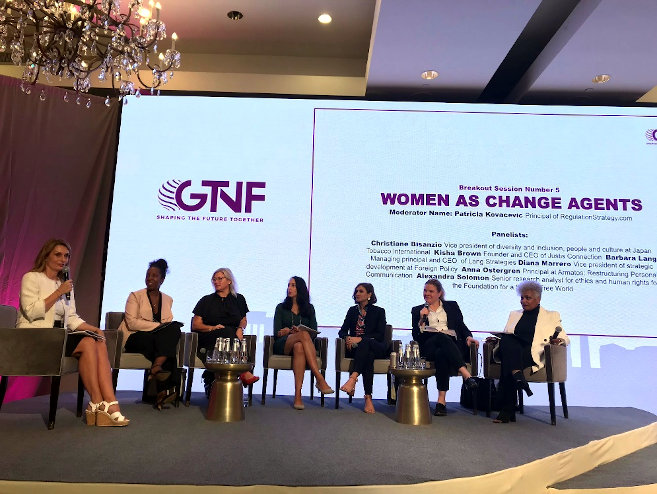
The Global Tobacco and Nicotine Forum (GTNF) is the world’s leading conference on the future of the tobacco and nicotine industries. The forum has convened every year since 2008; and this year, for the first time, it included a panel on women agents of change for sustainable development and harm reduction.
This GTNF session, for which I was a panelist, explored: How can women be levers for change as the industry transforms? How can both men and women contribute to accelerating gender equality in the industry? What concrete steps can companies take to ensure gender parity in leadership, scientific research, and new product development? How do we change the industry’s deep-seated cultural norms around gender inequality?
Here are highlights from our discussion:
Cross-Sector Collaboration
So-called “dirty industries”–such as tobacco, oil and gas, and mining–are often neglected by advocates of gender equality and diversity. Rather than engage these industries and support new efforts for sustainable development, some advocacy groups avoid them altogether. Through internal initiatives, dirty industries are beginning to clean up their acts. Yet, we can’t achieve true progress unless we work collectively. Institutional change will require collaboration between industry insiders, human rights and gender equality advocates, health professionals, and policymakers.
Strength in Numbers
Panelists discussed tactics women can employ to promote diversity, break through barriers to workplace equality, and eradicate women’s ladder-kicking tendencies.
“There is strength in numbers,” said Kisha Brown, Founder and CEO of Justis Connection. Speaking about her experience of being routinely underestimated by male colleagues, Brown emphasized the importance and power of sisterhood and of building strong relationships. Barbara Lang, Former DC Chamber of Commerce President, similarly urged women to support one another and to eradicate any ladder-kicking tendencies when feeling threatened by other women rising in the ranks. “When you arrive, make sure you are pulling someone else up with you,” she said. Anna Ostegren, principal at Armatos, spoke about the primary goal of her work: making sure women are equipped to push themselves forward in the workplace.
The Gender Pay Gap
As with many sectors, the gender pay gap plagues the tobacco industry and has remained unaddressed. According to publicly available data, one multinational tobacco company’s UK subsidiaries have, on average, a 34% gender pay gap in salaries and a 67% gap in bonuses. Such statistics should not go unnoticed. Christiane Bisanzio, Vice President of Diversity and Inclusion at Japan Tobacco International, elaborated on these concerns and spoke about the lack of a sense of urgency in industry with regard to gender diversity, inclusion, and equal pay.
Product Development and Pricing
I stressed the need for new products and services to account for the physiological and psychological differences between men and women—and the different types of men and women. Men and women are not monoliths. There is great intersectionality in identities that must be taken into account when developing innovative and affordable new solutions to smoking cessation and tobacco harm reduction.
The industry notoriously used product design and marketing, such as the Virginia Slim, as drivers of smoking uptake among women. Actors invested in public health and harm reduction must now design and market solutions in order to end smoking. As healthcare moves toward sex-differentiated treatment, so too should those in the private sector that are allocating resources to research and development (R&D). Further, more women should be employed in R&D and management in order to accelerate the development of products that suit their needs.
Takeaways
Discussions of gender appear to be part of a larger cultural movement within the tobacco industry, which is transforming in response to the global demand for change. There now exists motivation to shift toward sustainability and tobacco harm reduction. And this shift presents a unique opportunity in the industry to make progress toward gender equality. An emerging body of evidence shows that gender diversity is good for business, creativity, innovation, and transparency.
The 17 Sustainable Development Goals (SDGs) outlined in the 2030 Agenda for Sustainable Development provide an action plan for improving health and education, reducing poverty and inequality, spurring economic growth, and tackling climate change. The private sector—including the tobacco industry—can drive innovation and help create meaningful solutions to these complex systemic challenges.
© 2023 Foundation for a Smoke-Free World. All rights reserved.